A Simple, Un-Padded Tube-style Sling (Revised 5/8/2005)
New! If photographs are easier for you to "get", please check out these
new directions! I recommend comparing the two -- the method is the same, but the
illustrations are different.
Interesting note: the curved-seam pouch was invented by
Hygenia
Halfmoon, who then showed the method to Nancy Main, who started "New Native".
Now many pouches for sale are labeled "Native-style" even though they are a very
recent innovation (certainly not actually Native American), dating back to the
1970s with Hygenia's book "Primal Mothering in a Modern World". My thanks to Jenrose for
this tidbit.
A pouch-style sling should be between 20-22" wide before it's folded
for wearing (see below, or Hotslings.com for
great wearing directions) and 10-11" deep when folded.
PLEASE click and read the link (http://www.thebabywearer.com/articles/HowTo/Positioning.pdf)
-- it has VERY important information about correctly wearing a pouch or ring
sling!
This pattern is copyright to me (Jan Andrea)
and is NOT for resale under ANY circumstances!
Materials needed:
- Fabric: Between 1.5 and 2 yards of fabric, depending on your size;
the most you will need is 2 yards, unless you are built very large.
- This works fine with polar fleece!
- See the Fabric FAQ for specific fabric recommendations
and online sources
- Sewing machine and thread to match/contrast with the fabric. You could sew
this by hand, but unless you don't have a machine, I wouldn't recommend it!
- Time: under 1 hour, even if this is your first project!
 Before
you begin, you'll need to know how long to make the sling. Most pouch-style slings
are shaped so that the upper, open portion is shorter than the lower, folded
portion. This makes measuring for one a little tricky, since the place you measure
will impact the final size of the pouch, and therefore, how well it fits. The
black lines in the picture at right approximate the curve the pouch will take
when worn with a baby in a cradle hold. ( the grey lines show how the fabric will
likely spread across your back.) If you are currently pregnant, not to worry!
You'll be measuring mostly above the bump anyway, but if your tummy gets in the
way, just subtract a couple/few inches from the bottom/longer measurement.
Before
you begin, you'll need to know how long to make the sling. Most pouch-style slings
are shaped so that the upper, open portion is shorter than the lower, folded
portion. This makes measuring for one a little tricky, since the place you measure
will impact the final size of the pouch, and therefore, how well it fits. The
black lines in the picture at right approximate the curve the pouch will take
when worn with a baby in a cradle hold. ( the grey lines show how the fabric will
likely spread across your back.) If you are currently pregnant, not to worry!
You'll be measuring mostly above the bump anyway, but if your tummy gets in the
way, just subtract a couple/few inches from the bottom/longer measurement.
I used to recommend using two measurements (along the upper and then the lower
lines in the picture at right), but that seems to have caused more confusion
than anything else, so I'll go with what most people end up doing anyway. Measure
yourself from your shoulder to the opposite hip ( the point of your shoulder,
and the place on your hip where you rest your hand if you place your hand on
your hip -- this number will probably be somewhere between 20 and 30") and double
that measurement. Or, measure all the way around, from shoulder to opposite hip
and back up to that shoulder. Your final measurement will likely fall between
40" and 60", depending on your size.
If all else fails, try experimenting by folding the fabric as shown in the
instructions below and pinning it in different places, until it feels right.
Again, err on the larger side.
Seam and Baby Allowances:
| Worksheet |
Upper
(shorter) |
Lower
(longer) |
| Base measurement: |
|
|
| + seam allowance (2"): |
|
|
| + baby allowance (2-4"): |
|
|
| Final measurement (TLF): |
|
|
| 1/2 TLF (for cutting): |
|
|
Obviously, you'll need to add a little length for the baby. I would start
pretty conservatively, adding 2-4" to each measurement; you can always take
the pouch in if it's too big, but it's more difficult to add more material once
it's done. Then, you'll need to take a seam allowance into account. I use an
enclosed seam on this project, because the double seam makes it extra sturdy.
Allow about an inch on either side for the seam allowance -- so add another 2" to
your measurements. You'll have the longer of the two measurements + 2-4" baby
allowance + 2" seam allowance. This is the total length of fabric you'll
need -- henceforth referred to as TLF. ( the 6" addition is to the your *doubled*
measurement, if you've measured from your shoulder to your hip. So your final
number should be somewhere between 46-66".)
Polar fleece caveats:
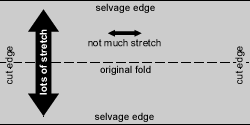 |
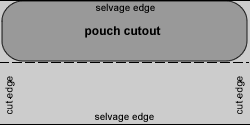 |
| Cutting stretchy fabrics -- always cut with
the majority of stretch going across its
width, not along the length of the carrier. |
Polar fleece usually has some stretch going from cut edge to cut edge, and
a lot of stretch going from selvage to selvage. Make sure you know
which direction is the stretchier one! My first polar fleece pouch was a
disaster because I had the stretchier direction going along the sling instead
of across it. It was always too tight when I had it on without Stephen in it,
and then stretched too much when I put him in. Also, you will probably find that
you can cut it to your actual around- the-chest measurement, instead of adding
a few inches, since it will stretch when you put the baby in. This goes for any
stretchy fabric.
When sewing with polar fleece (or other stretch fabrics), be sure to use a
stretch stitch. A simple zigzag is fine, or you can use one of the fancier stretch
stitches if your machine has them.
Pouch seam with fleece: in lieu of sewing a full French/flat felled seam as
below, you can just sew a sturdy seam (a couple of rows of zigzags, or another
stretch stitch), trim one side of the seam allowance to 1/4" less than the
other, and sew the wider seam allowance over the narrower one, again using a
stretch stitch. It's not quite as strong as the French/flat felled seam, but
it's plenty strong enough.
Making a tapered pouch:
I think the simplest way to do that would be to use the other
pouch directions,
and when cutting the top rail of your pouch, just make an angled cut in the fabric
ra ther than one straight across as shown. That will give the pouch some shape.
I think if you tried to do that with the fabric un-folded, it would be tricky
to make it symmetrical, though. (Note that this should be the *upper, shorter*
edge that is slanted, not the *lower, folded* edge.)
About the pouch width:
Wider is NOT better when it comes to pouches! The safest pouch is one that
will adequately enclose your baby, but which is not so deep that you have to
pull the fabric apart to see her inside it. A deeper pouch (more than 22-24"
from edge to edge) puts a baby at greater risk of positional
asphyxia, since it's harder for the wearer to see her position, plus the
additional depth can hamper proper positioning in the pouch. [PLEASE click and
read the link (http://www.thebabywearer.com/articles/HowTo/Positioning.pdf)
-- it has VERY important information about correctly wearing a pouch or ring
sling!] The vast majority of ready-to-wear pouches are between 20-24" wide,
and there is a good reason for that! You do not need to make a sling wider than
that, and I would strongly caution against it if you are considering it.
If you are using 54-60" fabric...
Cut the fabric so you have two pieces that are 1.5-2 yards long and
22" wide (this will make two slings, of course). There will also be a long
strip about 12" wide
left over; you can use it to make accessories, or make a child-sized sling to
match yours -- pouch or ring type :)
For 45" wide fabric...
You can either cut or fold it in half, so it's 22" wide. This works especially
well with calico prints; you can sew the edges together and then "quilt" the
layers for more strength. If your fabric is heavy enough without doubling, you
can cut it down the center fold and have two 22" wide slings. (Please feel
free to email me if this isn't clear
enough!)
For either width of fabric... |
Fold the fabric in half widthwise, then in half lengthwise:
(Image is intended to show all layers -- your fabric should be laid out more
neatly than this :) |
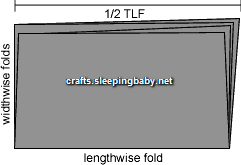 figure
2 figure
2 |
To make the pouch sling truly pouch-like, you'll need to cut a curve into
the unfinished edges:
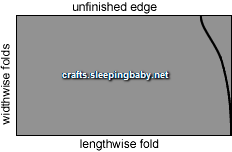 the
lengthwise fold should be the measurement you took (plus the seam and baby allowance),
and the unfinished edge, once cut, should be about 3" shorter than that. the
lengthwise fold should be the measurement you took (plus the seam and baby allowance),
and the unfinished edge, once cut, should be about 3" shorter than that.
Note that the curve straightens out as it approaches the unfinished edge.
This will make hemming the edges a lot easier; I would recommend having a straight
section about 1.5" long to accommodate a 3/4" rolled hem.
For polar fleece, you can make the curve less pronounced. |
I also recently made a pouch that wasn't symmetrical around
the foldline. That is, it was higher on the outside than it was on the inside,
so that the fabric went up higher on Sophie's back than it did underneath her.
To do this, when you're making the "smile" cut above, just fold the
fabric so that it's not quite in half along that lengthwise fold -- one edge
will be higher up than the other. Draw your smile as above. The shorter part
of the fabric will only get part of the "smile". When it's done, this
makes the pouch a little more comfortable in the hip carry, but shouldn't be
used for an infant in the cradle hold. |
Next, unfold the lengthwise fold, and sew the new curved cut edges toge
ther at about 1/4" from the edge, with the WRONG sides together. then
turn it wrong-side out and sew 1/2" from the first seam. This is a French sea.
To make it look neater, you can sew the hem down; then it's a sort of flat-felled seam
(like the ones on the legs of a pair of jeans). either way, it should look
fairly finished, as it may show when wearing the sling.
Here's an excellent photo
tutorial on making a flat-felled seam at Instructables. |
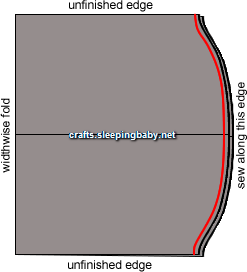 figure
4 figure
4 |
| Finally, fold the sling in half along the lengthwise again, so that the
seam you just sewed is on the inside and you have a tube of material with a fold
on one end and the curved seam on the other. Hem the unfinished edges separately.
To help the sling keep its shape while you wear it, you can make a very small
tacking stitch on the folded end, hemmed edge to hemmed edge (but wait until
after you've tried it on with the baby!), but the stitch is not strictly necessary,
and you may find it more comfortable without the stitch: leaving it off will
enable you to "flip" the pouch to change its fit. I hope this illustration
is clear enough -- it's supposed to show the tube shape, inside and out. |
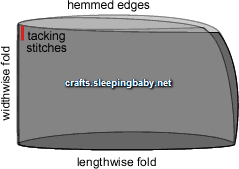 figure
5 figure
5 |
When you use the sling, the folded end will be at or near
your shoulder, and the baby's bottom should rest in the curved edge, the pouch
part, which will be between your hip and your chest (depending on where you want
the baby and how old s/he is). Try the sling on with your baby in it before you
put away the sewing machine. The baby should sit comfortably against your upper
torso. If s/he hangs too low, you may find that your back starts to hurt. If
the sling is too long, you can take it in along the shoulder -- the width-wise
fold. Unfold the lengthwise fold, so you have the D-shape as in figure 4, then
sew a seam along the widthwise fold. This is something you can take out later
as the baby grows.
The Peppermint
site has
some pictures that make wearing clearer, and there are great videos at Sprout
Pouch. |
Making a reversible pouch:
 This
is actually pretty simple. The easiest and safest way to do it is to cut your
fabrics to length as shown in the previous section, above. Here, the fashion
fabric is represented by the black and blue motif, and the inner/lining fabric
is bright blue. Stitching is shown in white. When cutting the curve, stack your
fabrics together, or cut one and then use it as a sort of pattern for the second
fabric. (That's probably the easiest if you're making a silk combination.) This
is actually pretty simple. The easiest and safest way to do it is to cut your
fabrics to length as shown in the previous section, above. Here, the fashion
fabric is represented by the black and blue motif, and the inner/lining fabric
is bright blue. Stitching is shown in white. When cutting the curve, stack your
fabrics together, or cut one and then use it as a sort of pattern for the second
fabric. (That's probably the easiest if you're making a silk combination.)
then, with right sides together, sew the two long edges, NOT the curved sections
just yet. |

Turn right-side-out, and topstitch the long edges.
Baste the curved edges, so they can be treated as one layer: |
 Now
you can sew the curve. Put your inside fabrics together and make a narrow seam
(about 1/4") along the curve. Make sure all four layers of fabric (two of the
outside fabric, two of the inside) are caught in the seam! Try on the pouch and
see how well it fits. You'll be taking another inch in the next step, but it
should be nearly fitted with this step. If it's too large, make another seam
parallel to the first, as far from that seam as necessary. Now
you can sew the curve. Put your inside fabrics together and make a narrow seam
(about 1/4") along the curve. Make sure all four layers of fabric (two of the
outside fabric, two of the inside) are caught in the seam! Try on the pouch and
see how well it fits. You'll be taking another inch in the next step, but it
should be nearly fitted with this step. If it's too large, make another seam
parallel to the first, as far from that seam as necessary.
You may need to trim some of the fabric inside that seam to make it about
3/8" wide. |

Turn
inside out, and stitch about 1/2" from the previous seam -- this makes a French
seam. All the raw edges will be enclosed, making this a neat and secure finish.
You can either leave the seam as it is, sticking up a bit, or sew it down. I
would recommend sewing it down, but be careful as you sew, since mistakes will
show up on the outside of the pouch. |

Now fold your pouch in half as above, so that the inner fabric
is inside, and the outer fabric is outside. |
| Reversible contoured pouch (pouch with a narrower shoulder) directions
here at Sweet Things Baby Slings |
Keeping a pouch sling in place:
I made myself a pouch like this out of
a prototype brocade/dupioni ring sling that I wasn't wearing anymore. I did find
that I wasn't happy wearing a pouch as-is -- the uninterrupted swa the of fabric
in front of me was irritating, and it never stayed in place. I remembered seeing
something I liked on someone else's pouch sales page a few years ago, though:
they'd taken a strip of fabric and wrapped it around the pouch, approximately
where the rings would be on a ring sling. This ga thers the material up, making
a much more comfortable shoulder that stays in place, and a less obtrusive swa the
of fabric in front. I've looked around, trying to find the inventor of this marvelous
innovation in pouches, but I can't find her site anymore. If you should happen
to know where it was, please let me know!
 Anyway,
to make this strip, I used a 10" by 5" strip of my lining material.
Fold the strip in half lengthwise (so it's 10" by 2.5"), then sew the
raw edges, leaving a small space for turning. Turn right side out, and topstitch
the edges. I put two snaps on each end to make it removable, but it turns out
I didn't really need to; I always use the sling with this strip in place. You
can use Velcro™,
snaps, or even a small buckle. If you don't want to use fasteners, just make
a longer strip initially and tie it instead, or use a piece of ribbon or whatever.
I find the pouch to be far more comfortable and useful with this in place. Anyway,
to make this strip, I used a 10" by 5" strip of my lining material.
Fold the strip in half lengthwise (so it's 10" by 2.5"), then sew the
raw edges, leaving a small space for turning. Turn right side out, and topstitch
the edges. I put two snaps on each end to make it removable, but it turns out
I didn't really need to; I always use the sling with this strip in place. You
can use Velcro™,
snaps, or even a small buckle. If you don't want to use fasteners, just make
a longer strip initially and tie it instead, or use a piece of ribbon or whatever.
I find the pouch to be far more comfortable and useful with this in place.
|
Reader suggestions:
Farha sent this idea: My sling is made from a double layer of cotton interlock
with 3% lycra for just a bit of stretch. I wanted to share a modification I made.
I added leg holes to make the sling more comfortable for both mom and baby as
baby gets bigger. My daughter rides facing me with her legs though the holes
cut into the inner section so she can straddle my hip. I get compliments on the
sling every time I wear it and most people are surprised to hear I made it myself.
Selling Pouches:
I get a fair number of emails from women who want to sell pouches locally
and want my permission to use the directions here. I've got no problem with people
using these directions to make and sell pouches, but there's way more to it than
that. Please read the three essays I've linked to on the index page
-- they should clear up some of those points. With pouches, there is an added
caveat. The trickiest part of making a pouch is the sizing, and the sizing is
really key for a safe and comfortable pouch. Too big, and the wearer's
back will hurt (since the baby will lie too far from her center of gravity),
and there's a risk that the baby can "flip out" of the pouch (or, alternatively,
be too curled up and risk oxygen deprivation). Too small, and it's impossible
to wear. The New Native pouches end up being too big (based on t-shirt sizing)
for most women, who then give up on slings unless they happen upon the right
size by chance. If you look at Hotslings and other WAHM pouch makers' sites,
you'll see that they tend to have fairly complicated sizing calculators, all
of which are proprietary, but this sort of system is really necessary to get
a well-fitted pouch. If you can manage to make testers for a lot of different-sized
women, that's one step towards success, but it takes a lot of work. That's one
of the reasons I don't sell pouches, even though they take less time to sew.
I just don't have the energy to make up a sizing table. It's hard enough with
a ring sling, which is still adjustable!
So, sure, make pouches for people you can fit in person and be sure that the
size is just right; but if you try to make just a few sizes and sell them to
all women, problems will result. either you'll face a constant stream of returns
for too big or too small slings, or your customers will attempt to wear the wrong-sized
sling, and that is a hazard for them and, by extension, for you. I've seen several
women in Dover alone who bought pouches from a local vendor. Her sizing seems
to be all off, unfortunately, since the majority of women had to keep one arm
around their babies in the sling -- they were sitting at hip level and leaning
way back, both of which are signs of a far-too-large pouch. I've advised them
to return the pouches, but there's not much else that can be done until the vendor
realizes that she's selling an unsafe product. Don't let that happen to you!
other pouch sewing directions on the web:
All content, barring that which is otherwise attributed, is ©2023 to
Jan Andrea. If you wish to use my content on another page, please email before
doing so, even for content with the Creative Commons licenses. Text/images used
elsewhere must be attributed to me. Be advised that I will pursue copyright
violations.
 Before
you begin, you'll need to know how long to make the sling. Most pouch-style slings
are shaped so that the upper, open portion is shorter than the lower, folded
portion. This makes measuring for one a little tricky, since the place you measure
will impact the final size of the pouch, and therefore, how well it fits. The
black lines in the picture at right approximate the curve the pouch will take
when worn with a baby in a cradle hold. ( the grey lines show how the fabric will
likely spread across your back.) If you are currently pregnant, not to worry!
You'll be measuring mostly above the bump anyway, but if your tummy gets in the
way, just subtract a couple/few inches from the bottom/longer measurement.
Before
you begin, you'll need to know how long to make the sling. Most pouch-style slings
are shaped so that the upper, open portion is shorter than the lower, folded
portion. This makes measuring for one a little tricky, since the place you measure
will impact the final size of the pouch, and therefore, how well it fits. The
black lines in the picture at right approximate the curve the pouch will take
when worn with a baby in a cradle hold. ( the grey lines show how the fabric will
likely spread across your back.) If you are currently pregnant, not to worry!
You'll be measuring mostly above the bump anyway, but if your tummy gets in the
way, just subtract a couple/few inches from the bottom/longer measurement. 

 figure
2
figure
2 the
lengthwise fold should be the measurement you took (plus the seam and baby allowance),
and the unfinished edge, once cut, should be about 3" shorter than that.
the
lengthwise fold should be the measurement you took (plus the seam and baby allowance),
and the unfinished edge, once cut, should be about 3" shorter than that.  figure
4
figure
4 figure
5
figure
5 This
is actually pretty simple. The easiest and safest way to do it is to cut your
fabrics to length as shown in the previous section, above. Here, the fashion
fabric is represented by the black and blue motif, and the inner/lining fabric
is bright blue. Stitching is shown in white. When cutting the curve, stack your
fabrics together, or cut one and then use it as a sort of pattern for the second
fabric. (That's probably the easiest if you're making a silk combination.)
This
is actually pretty simple. The easiest and safest way to do it is to cut your
fabrics to length as shown in the previous section, above. Here, the fashion
fabric is represented by the black and blue motif, and the inner/lining fabric
is bright blue. Stitching is shown in white. When cutting the curve, stack your
fabrics together, or cut one and then use it as a sort of pattern for the second
fabric. (That's probably the easiest if you're making a silk combination.)
 Now
you can sew the curve. Put your inside fabrics together and make a narrow seam
(about 1/4") along the curve. Make sure all four layers of fabric (two of the
outside fabric, two of the inside) are caught in the seam! Try on the pouch and
see how well it fits. You'll be taking another inch in the next step, but it
should be nearly fitted with this step. If it's too large, make another seam
parallel to the first, as far from that seam as necessary.
Now
you can sew the curve. Put your inside fabrics together and make a narrow seam
(about 1/4") along the curve. Make sure all four layers of fabric (two of the
outside fabric, two of the inside) are caught in the seam! Try on the pouch and
see how well it fits. You'll be taking another inch in the next step, but it
should be nearly fitted with this step. If it's too large, make another seam
parallel to the first, as far from that seam as necessary. 

 Anyway,
to make this strip, I used a 10" by 5" strip of my lining material.
Fold the strip in half lengthwise (so it's 10" by 2.5"), then sew the
raw edges, leaving a small space for turning. Turn right side out, and topstitch
the edges. I put two snaps on each end to make it removable, but it turns out
I didn't really need to; I always use the sling with this strip in place. You
can use Velcro™,
snaps, or even a small buckle. If you don't want to use fasteners, just make
a longer strip initially and tie it instead, or use a piece of ribbon or whatever.
I find the pouch to be far more comfortable and useful with this in place.
Anyway,
to make this strip, I used a 10" by 5" strip of my lining material.
Fold the strip in half lengthwise (so it's 10" by 2.5"), then sew the
raw edges, leaving a small space for turning. Turn right side out, and topstitch
the edges. I put two snaps on each end to make it removable, but it turns out
I didn't really need to; I always use the sling with this strip in place. You
can use Velcro™,
snaps, or even a small buckle. If you don't want to use fasteners, just make
a longer strip initially and tie it instead, or use a piece of ribbon or whatever.
I find the pouch to be far more comfortable and useful with this in place.